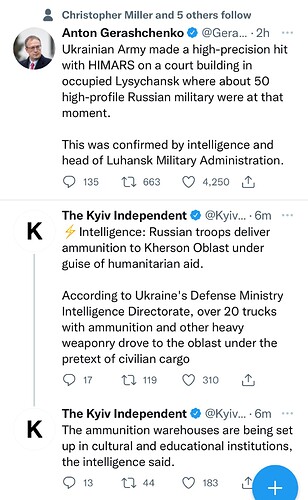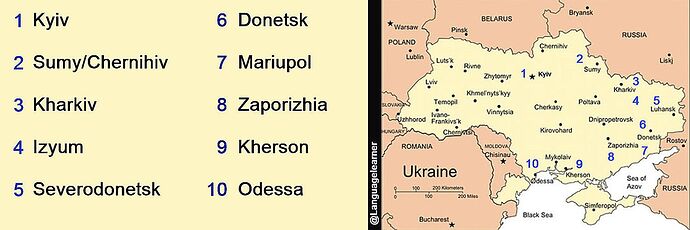7.23.22 Update, day 150 of Russian invasion.
Belarus:
Belarus has again extended their military drills to July 31st, the 13th time it was extended/ It is unlikely they will physically participate in the war however.
Kyiv/ West Ukraine (1):
The situation remains unchanged in W Ukraine.
Additional strikes were launched on Kyiv, with damage to a university and apartment blocks.
In central Ukraine, 13 RU missiles were fired into Kirovohrad, targeting the military airfield and electrical/train infrastructure.
Sumy/Chernihiv (2):
RU forces continue to consolidate themselves along the border, and fired across the border with mortars. There appears to be no formation of RU assault groups as of yet, or preparations for a renewed ground assault. The increased usage of automatic grenade launchers is observed.
Kharkiv (3):
RU forces continue to skirmish along the front lines N of kharkiv, with an RU attempt towards Udy being repelled in the area UA controls closest to the border. Airstrikes continue on UA positions in Verkhnii Saltiv, who are the closest to menacing Vovchansk and the RU supply lines therein.
Izyum/Lyman (4):
RU forces N of Slovyansk continue to skirmish into the area of Borodychne, and have been generally prevented from advancing by way of UA artillery sighted into the rubble of the town. RU forces continue to shell along the front lines, and have reportedly been repelled from around the town on the leading edge of the advance to Slovyansk, Krasnopillya. which lies just along the main highway south.
UA forces continue to shell into the RU backlines, both immediatly inside Izyum, and also along the far riverbank in Svyatohirsk, which lies right across from the rubble formerly known as Borodychne, and has been an RU command post since at least May.
Siversk/Lysychansk (5):
An RU meeting between 50 commanders and staff in Lysychansk courthourse was interrupted by accurate UA artillery fire to devastating effect.
RU forces again attacked towards Siversk, both along the central and southern fronts towards Verhkhnokamyanske and Ivano-Darivka, both attacks were repelled.
There is evidence of UA MLRS strikes on RU bases in Verkhnokamnyanka, the site just E along the main road from Siversk to Lysychansk, and the industrial area that UA covered the withdrawl from Lysychansk in.
Increased RU shelling NW of Siversk appears to originate from across the river, and is designed to limit supplies and troops redeploying. Additionally, while the volume of fire along the eastern front line appears steady, there has been increased RU strikes on the southern route into Siversk, along the T05-13 highway, which runs dune north from Bakhmut.
Popasna/Bakhmut:
RU forces attempted attacks along the NE highway from Bakhmut towards Berestove, Bilohorivka, and Yakovilvka, and appear to have dislodged UA defenders from Berestove itself, with UA strikes targeting into the town and RU strikes now targeting increasingly west of the town into the hills. The UA strongpoint further west of Vesele continues to be supplied, and a corresponding attack to the south in Bilohorivka was repelled, with UA forces continuing to shell RU supply routes sustaining this assault.
Around Bakhmut, RU forces attempted an attack on the UA defensive strongpoint of Soledar, but were repelled and had their supply lines struck. Due E of Bakhmut however, per the UA MoD, Wagner group mercs succesfully assaulted into the southern half of the town of Pokrovske. Pokrovske luies along the main highway towards Bakhmut, and is the final main residential area before entering Bakhmut proper. The increased usage of CAS in this assault is reminiscint of the final portion of the battle of Popasna, where Wagner PMC aircraft managed to dislodge UA defenders. It remains to be seen if this is a concerted attempt a la popasna, or a smaller force, as UA continues to shell the Russian backlines here, and the Wagner PMC operating base located just a few KM further east along the river from Illovaisk.
RU forces continue to attempted to close the UA pocket to the SE of Bakhmut around the Vulehirska coal power plant, which lies along the the Luhan river reservoir and effectively allows UA troops to control movement through the area from this industrialized strongpoint. The intensity of RU attacks in this region has diminished slightly after they attempted attacks from multiple directions simultaneously earlier on in the week. There are increased UA strikes into Luhanske and Svitlodarsk, RU command/supply hubs for this push.
Donetsk (6):
The video evidence purportedly showing a HIMARS being destroyed several days ago, is reported by both the US government and RU military celebrity Igor Girkin as false. The DOD stated that no US MLRS systems have been destoyed as of yet, and Igor Girkin continues to bemoan the fact that RU lacks effective countermeasures to stop them from striking.
RU volunteer battalions from Chechnya are walking back their rhetoric of rapid deploying into Ukraine, following some domestic pushback against Kadyrov. The increased reporting on the dramatically unfit and undertrained “volunteer” battalions forming around russia as part of Putins “shadow mobilization” has generated a surprising amount of angst and aggravation among the citizenry, who can plainly see that this is more of a desperation move then groups of highly motivated soldiers signing up. Allegedly, the RU government has limited its goals to now 24 battalions being formed (8 formed, 16 more reqeusted) in the next few weeks, as opposed to the orginal stated plan of at least 1 battalion per region in Russia, of which there are 84. The ethnic minority regions are seeing more of this behavior then the ethnic Russian metropolises in the W, such as Moscow, St Petersburg, and the like.
RU ammo depots near Donetsk city such as Horlivka continue to be hit.
RU continues to shell into Avdiivka, and has attempted no further ground assaults. Overall, there continues to be a reduction in the volume of RU artillery fire, attributed to the destruction of RU logistics and command bases in the backline.
Mariupol (7):
The situation remains grim in Mariupol. RU is accelerating it’s plans to block the flow of any information in and out of the region, as well as staging sham referendums for the occupied areas in the south by autumm.
Zaporizhia/Southern Axis (8):
RU forces continue to leverage artillery and rocket fire across the southern front, but launched no major offensives.
UA released video footage of the effects of precision strikes carried out by loitering munitions on RU positions near the Zaporhizia NPP, which were able to effectively target RU MLRS and troops within 350m of the nearest nuclear infrastructure. The RU battle strategy of using nuclear and other sensitive infrastructure as a “shield” against enemy attacks appears to be less effective in the presence of highly-accurate and controllable suicide drones.
RU forces have taken significant losses in the South, and reportedly the remains of 3 battalions are constituted together in order to form a new one. In that specific unit, 2000 reinforcements arrived since the war began, and only 500 are still alive, and that even the increased deployment of psychologists is not helping convice RU soldiers to redeploy back to Ukraine or go on assault. The RU soldier also stated that the Ukrainians artillery capabilities have improved so much that they no long have warning time before the explosions, which has created a sense of general dread.
Kherson (9):
RU and UA forces continue to fire artillery at each other along the front line, and RU MI-8 gunships (a transport helicopter which can also fire missiles, but not a dedicated gunship) continue attempts to strike UA positions with minimal effect. RU forces fired another batch of S-300 missiles in Mykolaiv, and attempted an assault with antiquated T-62 tanks along the front line which was repelled. UA forces destroyed 3 of these old tanks, and two ammo dumps/logistics hubs in Kherson.
Per Zelensky, the offensive to retake Kherson oblast continues in a slow grinding pace, with rocket strikes and shelling to be expected. Per RU military reports, UA still maintains a bridgehead across the Inhulets river near Lozove, which has drawn significant RU attention in the form of mines and artillery in order to prevent another UA assault forming there.
The reports of an RU grand encirclement in Vyskopillya by UA troops remain unconfirmed at best, with the city having been reduced to rubble some time ago and unlikely to have been held onto unneccesarily by increasingly menaced RU troops.
RU forces in Kherson have stepped up their anti-partisan measures, and are going house to house to check for weapons caches and other signs of resistance. Snipers have been deployed to watch for “suspicious activity” of Ukrainians standing in high rise windows, with incredibly loose ROE for what constitues a Ukrainian spotter, and subsequently an RU team being sent in. Due to the increased UA strikes in the region, RU forces are increasinly prohibited from moving military equipment or manpower during daylight hours.
A Ukrainian government minister fighting in the south was reportedly saved from an RU bombardment by a simple mattress he threw up on the window.
Odessa/Black Sea/Crimea(10):
This morning, the RU black sea fleet fired 4 missiles into the Odesa port, targeting infrastructure faacilities thereof. 2 were intercepted, and the other 2 hit near loading centers which are to be used for offloading grain onto ships following the previously announced “grain deal” Russia had agreed to. It is believed that the strikes were focused on on the grain storage itself, but the infrastructure for moving them, in a way to slow the pace of any transloading.
Reportedly in the black sea, there are 2 missile ships and 2 submarines, as well as 1 transport ship equipped with up to 12 Kaliber cruise missiles.
The UA military stated that the UA ports of Odesa, Chornomorsk, and Pivdenny will be ready for grain export by the end of the week following mine clearing operations. They also stated that there is functionally no chance of an RU Naval invasion attempt, due to the increased posture of UA anti-ship forces, and the increasingly eastern deployments of the black sea fleet around crimea.
Moldova has confirmed that it is not allowing any RU military personnel in Transnistria to enter or transit through Moldova.
A cat, which was rescued from Snake Island, got the name Snake as it has become something of a mascot for the defenders in the south.
RU forces targeted the landmark Adzhigol lighthouse with 3 missiles, the tallest lighthouse in ukraine.
General:
Yesterday, Ukrainian forces eliminated:
240 x soldiers (Total 39,240)
4x tanks
9x APC
3x Artillery (2x MLRS)
17x vehicles
1x UAV
The greatest losses were in the Kramatorsk and Bakhmut regions.
UN Secretary General António Guterres “unequivocally” condemned the shelling of the Odesa seaport, from where the export of Ukrainian grain was supposed to resume. Turkish Defense Minister Hulusi Akar said that the Russian side claims that it has nothing to do with the missile attack on the Odesa port and is “studying this issue in detail.”
UK PM Boris Johnson said that last week he visited the training camp of Ukrainian servicemen in North Yorkshire and even trained with them, releasing a video.
The US announced another 270 million USD packaged, comprised of
4 HIMARS and support vehicles, 36k 105mm Artillery rounds for light NATO artillery, anti tank weaponry, and up to 580 Phoenix Ghost drones. The Phoenix Ghost is believed to be a modern long range loitering munition, developed in part by DARPA following the usage of Switchblade drones on the battlefield. It has a larger warhead and range.
Looking forward:
RU artillery strikes have continued to diminish in effectiveness, as a result of UA strikes on ammo depots.
RU forces near Kherson are increasingly on edge for potential UA strikes, and the movement of ammo depots further behind the lines indicate the concern applied.


